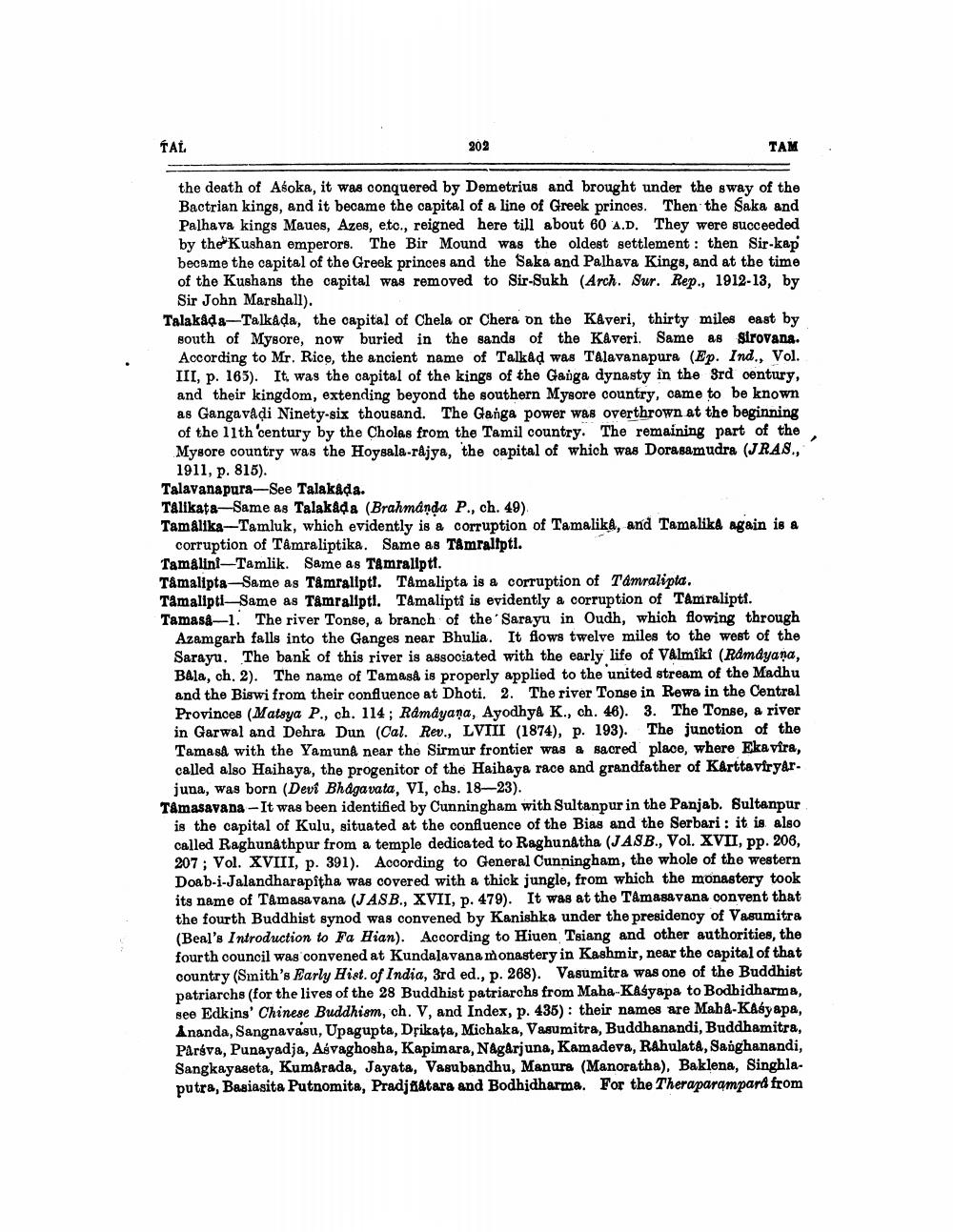________________
TAL
202
TAM
the death of Asoka, it was conquered by Demetrius and brought under the sway of the Bactrian kings, and it became the capital of a line of Greek princes. Then the Saka and Palhava kings Maues, Azes, etc., reigned here till about 60 A.D. They were succeeded by the Kushan emperors. The Bir Mound was the oldest settlement: then Sir-kap became the capital of the Greek princes and the Saka and Palhava Kings, and at the time of the Kushans the capital was removed to Sir-Sukh (Arch. Sur. Rep., 1912-13, by Sir John Marshall).
Talakada-Talkaḍa, the capital of Chela or Chera on the Kaveri, thirty miles east by south of Mysore, now buried in the sands of the Kaveri. Same as Sirovana. According to Mr. Rice, the ancient name of Talkaḍ was Talavanapura (Ep. Ind., Vol. III, p. 165). It was the capital of the kings of the Ganga dynasty in the 3rd century, and their kingdom, extending beyond the southern Mysore country, came to be known as Gangavadi Ninety-six thousand. The Ganga power was overthrown at the beginning of the 11th century by the Cholas from the Tamil country. The remaining part of the Mysore country was the Hoysala-rajya, the capital of which was Dorasamudra (JRAS., 1911, p. 815).
Talavanapura-See Talakada.
Talikata Same as Talakâda (Brahmânḍa P., ch. 49).
Tamalika-Tamluk, which evidently is a corruption of Tamalika, and Tamalika again is a
corruption of Tâmraliptika. Same as Tâmralipti.
Tamalini-Tamlik. Same as Tamralipti.
Tâmalipta-Same as Tâmralipti. Tâmalipta is a corruption of Tamralipta. Tamalipti Same as Tâmralipti. Tamalipti is evidently a corruption of Tamralipti. Tamasa-1. The river Tonse, a branch of the Sarayu in Oudh, which flowing through Azamgarh falls into the Ganges near Bhulia. It flows twelve miles to the west of the Sarayu. The bank of this river is associated with the early life of Valmiki (Ramayana, Bala, ch. 2). The name of Tamasâ is properly applied to the united stream of the Madhu and the Biswi from their confluence at Dhoti. 2. The river Tonse in Rewa in the Central Provinces (Matsya P., ch. 114; Ramayana, Ayodhya K., ch. 46). 3. The Tonse, a river in Garwal and Dehra Dun (Cal. Rev., LVIII (1874), p. 193). The junction of the Tamasa with the Yamuna near the Sirmur frontier was a sacred place, where Ekavira, called also Haihaya, the progenitor of the Haihaya race and grandfather of Karttaviryarjuna, was born (Devi Bhagavata, VI, chs. 18-23). Tâmasavana-It was been identified by Cunningham with Sultanpur in the Panjab. Sultanpur is the capital of Kulu, situated at the confluence of the Bias and the Serbari: it is also called Raghunathpur from a temple dedicated to Raghunatha (JASB., Vol. XVII, pp. 206, 207; Vol. XVIII, p. 391). According to General Cunningham, the whole of the western Doab-i-Jalandharapitha was covered with a thick jungle, from which the monastery took its name of Tâmasavana (JASB., XVII, p. 479). It was at the Tâmasavana convent that the fourth Buddhist synod was convened by Kanishka under the presidency of Vasumitra (Beal's Introduction to Fa Hian). According to Hiuen Tsiang and other authorities, the fourth council was convened at Kundalavana monastery in Kashmir, near the capital of that country (Smith's Early Hist. of India, 3rd ed., p. 268). Vasumitra was one of the Buddhist patriarchs (for the lives of the 28 Buddhist patriarchs from Maha Kasyapa to Bodhidharma, see Edkins' Chinese Buddhism, ch. V, and Index, p. 435): their names are Maha-Kasyapa, Ananda, Sangnavasu, Upagupta, Drikata, Michaka, Vasumitra, Buddhanandi, Buddhamitra, Paráva, Punayadja, Asvaghosha, Kapimara, Nagarjuna, Kamadeva, Rahulata, Sanghanandi, Sangkayaseta, Kumarada, Jayata, Vasubandhu, Manura (Manoratha), Baklena, Singhlaputra, Basiasita Putnomita, Pradjñatara and Bodhidharma. For the Theraparampard from




